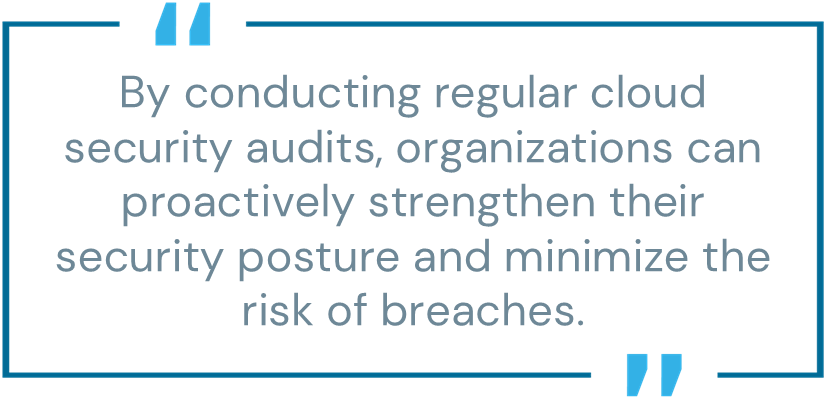
The cloud has enabled faster, more reliable and more scalable software delivery for organizations. Alongside these improvements come greater complexity and security considerations, all of which have implications when preparing for cloud security audits.
Like all security audits, cloud security audits help ensure that data is kept safe from unauthorized access and theft. They are a comprehensive evaluation of an organization’s cloud infrastructure, policies and procedures to assess their effectiveness in safeguarding sensitive data and ensuring compliance with regulatory standards.
Cloud security audits typically cover areas such as identity and access management (IAM), data protection, incident response, encryption and compliance with standards like GDPR, HIPAA and ISO 27001.
By conducting regular cloud security audits, organizations can proactively strengthen their security posture and minimize the risk of breaches.

Top Goals of Cloud Security Audits
Cloud security audits typically cover five main objectives:
- Identify risks: Highlight vulnerabilities in cloud configurations, access controls and policies.
- Ensure compliance: Verify adherence to industry regulations and internal security standards.
- Evaluate security controls: Assess the effectiveness of security measures, such as firewalls, encryption and monitoring systems.
- Enhance incident response: Test the organization’s preparedness for detecting and responding to security incidents.
- Improve accountability: Provide clear documentation of security practices and roles, ensuring transparency for stakeholders.
Though the aims of cloud security audits are relatively straightforward, the nature of cloud environments also poses specific challenges for organizations looking to maximize their security posture in the cloud.
Common Hurdles in Cloud Security Audits
The benefits mentioned earlier, like faster, more reliable and more scalable software delivery, allow organizations to innovate. However, with this greater flexibility and speed come significant security, audit and compliance challenges.
These are some of the most common challenges when conducting a cloud security audit:
1. Complexity of Cloud Environments
- Challenge: Cloud ecosystems often involve multiple cloud service providers (CSPs) like AWS, GCP and Azure. Hybrid setups, which are a mix of on-premises and cloud-based systems, can also add complexity to the environment, especially when it comes to visibility and data governance.
- Impact: This complexity can make gaining a comprehensive view of security controls and configurations difficult.
2. Shared Responsibility Model
- Challenge: Cloud service providers (CSPs) and customers share security responsibilities, which can create ambiguity about who is accountable for specific controls. In addition, each CSP has a different shared responsibility model to address.
- Impact: Misunderstandings can leave critical security gaps unaddressed.
3. Dynamic Nature of the Cloud
- Challenge: Cloud environments are highly dynamic, with frequent configuration changes, user roles and workloads. This highlights how a major advantage of the cloud can also present a security challenge.
- Impact: Continuous changes increase the risk of misconfigurations and make it harder to maintain an accurate inventory of resources.
4. Insufficient Visibility
- Challenge: Limited visibility into cloud workloads and data flows can hinder effective auditing.
- Impact: Blind spots in monitoring can lead to undetected vulnerabilities.
5. Regulatory Complexity
- Challenge: Compliance requirements vary across industries and jurisdictions.
- Impact: Keeping up with diverse regulations and ensuring compliance can be resource intensive.
6. IAM Challenges
- Challenge: Managing access to cloud resources across multiple platforms can be difficult, especially with roles like developers. Often, this role is overprivileged due to the widely varied access needs of engineers to fix problems that arise in software.
- Impact: Weak identity security is a common entry point for attackers. In fact, according to the IBM X-Force Threat Intelligence Index 2024, incident response data indicates a 71% increase year over year in the volume of attacks using valid credentials.
Given the numerous cloud-specific challenges involved in an audit, it’s crucial to follow best practices to help ensure a smooth and successful process.
Preparing for Cloud Security Audits: Best Practices
Effective preparation for a cloud security audit is essential to streamline the process and achieve success.
A key first step is understanding the shared responsibility model. Organizations should clearly define their security responsibilities and those of their cloud service provider (CSP) that comprise their cloud environments. Reviewing the CSP’s security documentation will help in understanding the controls they provide and identifying those that the organization must implement independently.
Conducting a pre-audit assessment is another best practice. Performing an internal review helps identify potential gaps in the cloud security framework. Organizations can use vulnerability scanning tools to detect misconfigurations, outdated controls and other weaknesses that might compromise security. This proactive approach can help address issues and cut down on surprises before the formal audit process even begins.
Maintaining a comprehensive inventory of cloud resources is also vital. Organizations should keep an up-to-date record of all applications, VMs, storage systems and network components. Additionally, documenting data flows and storage locations ensures sensitive data is being protected and aligns with compliance requirements.
Building on the IAM challenges discussed earlier, strong IAM practices play a significant role in cloud security. Role-based access control (RBAC) should be adopted to limit user permissions based on specific roles, and of course MFA should be enforced for all users–especially those with administrative privileges. These measures reduce the risk of unauthorized access and enhance overall security.
Regular monitoring and logging of activities is another way to cut down on audit friction. Cloud-native monitoring tools can track access attempts, data transfers and configuration changes, while logging critical events provides a clear audit trail. And the final step for logging and monitoring? Securely storing logs to ensure they are available for review during audits.
Data encryption is another cornerstone of cloud security. Organizations should encrypt sensitive data both in transit and at rest, ensuring that encryption keys are securely managed and rotated periodically. This minimizes the risk of data breaches and demonstrates compliance with security standards.
Speaking of standards, it’s also crucial to ensure alignment with regulatory standards for organizations operating under specific legal and industry requirements. Familiarity with frameworks like SOC 2, GDPR or HIPAA is necessary and using compliance checklists can help ensure all relevant requirements are met.
Employee training also helps to maintain a secure cloud environment. Regular education on cloud security best practices, along with workshops and simulations, prepares staff for potential security incidents and reinforces their role in compliance efforts.
Finally, organizations should document their policies and procedures thoroughly. Clear records of security policies, incident response plans and audit trails are essential for demonstrating compliance. Providing auditors with easy access to these records can help to ensure a smooth and efficient audit process.
With a wide range of best practices to ensure your organization is prepared for a cloud security audit, it’s helpful to understand how to set the foundation for successfully following them. In cloud security, begin with identity.
Harnessing Cloud Identity Security for Audit Readiness
Cloud identity security is a foundational element of a successful cloud security framework. As the first line of defense against unauthorized access, identity security ensures that only legitimate users and devices can access cloud resources.
Here’s how it plays a pivotal role in preparing for a cloud security audit:
- Strengthening access controls: Implementing RBAC and least privilege policies reduces the risk of over-permissioned accounts. Excessive permissions for users, especially developers and engineers, pose a significant risk. Well-defined access controls demonstrate minimized attack vectors during an audit.
- Enforcing MFA: Adaptive MFA adds an extra layer of security, reducing the risk of credential-based attacks. Auditors often verify that MFA is enforced for critical accounts, but best practices dictate MFA for all accounts.
- Centralizing identity management: Centralized identity platforms simplify the management of user roles and permissions across multiple cloud and hybrid environments. This approach helps to ensure consistency in identity governance, a key focus area in audits.
- Ensuring visibility and accountability: Cloud identity solutions provide detailed logs of authentication attempts, privilege escalations and user activities. These logs serve as vital evidence for auditors, help detect anomalies and simplify cloud audits.
- Simplifying user lifecycle management: Automated identity lifecycle management ensures timely provisioning and deprovisioning of user accounts. Properly managed identities can help eliminate risks from orphaned accounts, a common finding in audits.
Building a Resilient Cloud Security Framework
Preparing for a cloud security audit can be a daunting task, but with the right strategies, tools and practices, organizations can navigate the process with confidence. Beyond that, cloud identity security builds a solid foundation in ensuring audit readiness by safeguarding access to critical resources, enforcing compliance and providing the visibility needed to detect and respond to potential threats.
By prioritizing strong identity governance, utilizing advanced authentication methods and maintaining a clear audit trail, businesses can not only excel in cloud security audits but also build a resilient foundation for their cloud operations. As cloud environments continue to evolve, investing in granular cloud identity security is no longer optional—it’s a necessity for any organization aiming to thrive in today’s digital landscape.
Want to explore how easy implementing zero standing privileges can be? Get started with your free CyberArk Secure Cloud Access trial in minutes.
Alyssa Miles is a product marketing manager at CyberArk.























